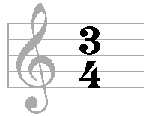Rhythm and Meter: An Introduction (part 4)
Composers have developed a way to indicate the meter of a particular piece by placing one number above another number at the start of a section of music. This number system is called a time signature and looks like this:  .
The top number tells how many of a particular note value are found in a measure, while the bottom number tells what the normative note value is, that is, what note value is being counted.
.
The top number tells how many of a particular note value are found in a measure, while the bottom number tells what the normative note value is, that is, what note value is being counted.
The time signature above tells the performer that there are three beats in every measure and that the quarter note gets the beat.
Similarly a time signature of 5 over 4, will tell the performer that there are 5 beats in a measure and the quarter note gets the beat; a time signature of 7 over 8 says that there are 7 beats in a measure and the eighth note gets the beat; and a signature of 3 over 1 says that there are 3 beats to a measure and the whole note gets the beat. Bear in mind, however, that the time signature of a composition says nothing about the tempo of a work, that is how fast or slow a particular piece should proceed.
How do I determine the meter of a selection?
There is no hard and fast rule to determine the meter of a selection. Listen for repeating units, whether harmonically, melodically, or more likely in phrases in either the melody or the accompaniment. Listen for repeating series of accents, such as "oom-pah-pah." Catch the beat of the selection and try counting along with it in two or in three. Generally, more "comfortable" word accents or melodic accents will fall on the downbeat. If both two and three feel comfortable, consider six. If neither does, consider something more complicated like five.
Perhaps try conducting along with the selection. To conduct in two, simply move your arm in a down-up pattern. To conduct in three, trace a triangle in the air: down - out - up.
Index
All text © Todd Tarantino 2002-2012.
Not to be reprinted without permission.
www.toddtarantino.com
Contact
 .
The top number tells how many of a particular note value are found in a measure, while the bottom number tells what the normative note value is, that is, what note value is being counted.
.
The top number tells how many of a particular note value are found in a measure, while the bottom number tells what the normative note value is, that is, what note value is being counted.